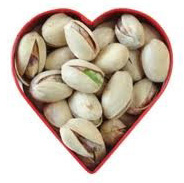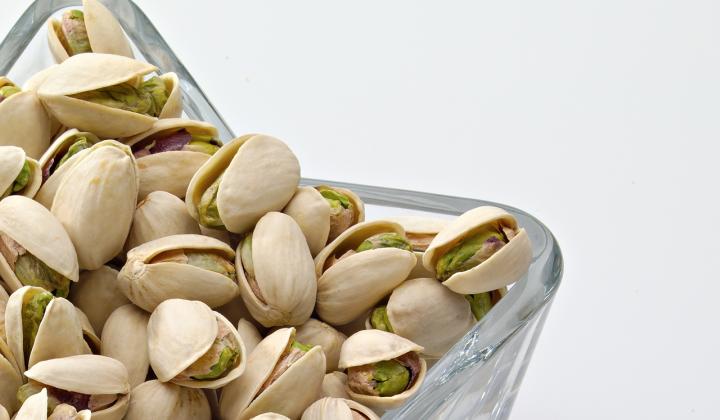California Pistachios: The Heart Smart Snack
 A handful of California pistachios a day can promote heart health. Snack healthfully to lower the burden of heart disease and diabetes in your household. Developing healthy eating habits is the most important step in lowering the risk for heart disease and diabetes in the most productive years.
A handful of California pistachios a day can promote heart health. Snack healthfully to lower the burden of heart disease and diabetes in your household. Developing healthy eating habits is the most important step in lowering the risk for heart disease and diabetes in the most productive years.
California pistachios are healthful and delicious roasted when eaten as a snack and can also add nutritional value as an ingredient in curries, pulav and desserts. Historically, pistachios were considered to be a “royal” and nutritious nut and date back to 6750 BC.
California pistachios are a nutrient-dense food with heart- healthy fats as well as protein, dietary fiber, potassium, magnesium and anti-oxidants such as gamma tocopherol and phytochemicals lutein and anthocyanin that give the unique green and purple kernel color.
This nut has an impressive body of research to support its unique place in a heart-healthy diet. So what can pistachio consumption do for you? Pistachios can:
Improve nutrient intake. Thirty grams of California pistachios have as much protein as an egg, about 3 grams of dietary fiber, low amount of the bad fats (saturated fats) and a high amount of the good fats (monounsaturated fat) and among all nuts, they are one of the lowest in overall fat and highest in potassium and have a low glycemic index. California pistachios are an excellent source of magnesium and are low in sodium and they have a satiating effect by giving you a satisfying and full feeling.
- Lower the LDL-cholesterol (also known as the bad cholesterol) by 6%-11%.
- Lower triglyceride levels when substituted for refined carbohydrates.
- Improve blood glucose levels to reduce the risk for diabetes and coronary heart disease.
- Improve blood pressure.
- Help control body weight
Why should Indians be concerned about these risk factors?
Epidemiologic studies have suggested that Indians have a significantly higher prevalence of coronary heart disease (CHD) and several-fold higher rates than other ethnic groups known to have an increased prevalence of CHD.
Prevalence of cardiovascular disease (CVD) risk factors such as dyslipidemia, diabetes and insulin resistance, and increased abdominal fat have been documented in South Asians. In addition emerging risk factors such as elevated C-reactive protein levels and homocysteinemia are prevalent in Indians.
More and more young adults living in urban areas are developing diabetes, hypertension and obesity. This was shown in a study conducted in 1100 young adults from New Delhi. Over the seven years of the study, the prevalence of these risk factors for heart disease climbed up. Waist circumference rose from 50% to 70%, hypertension from 11% to 34% among men and 5% to 15% among women. Diabetes prevalence rates DOUBLED. These data are a red flag for heart health among Indians. India accounted for 60% of world’s heart disease cases in 2010. What’s even more disturbing is that Indians get heart attacks at a younger age compared to the rest of the world!
Prevention of the metabolic syndrome is an important step in reducing heart disease and diabetes among Indians. A low-fat, high carbohydrate diet may not benefit Indians because it may accentuate metabolic abnormalities such as high plasma triglycerides, low HDL cholesterol, and the presence of insulin resistance.
Nutrition guidelines around the world often focus on the following:
- Addressing weight management (reducing abdominal fat) with physical activity and calorie control
- Decreasing intakes of refined carbohydrates
- Increasing intake of omega-fatty acids
- Decreasing intake of saturated and trans fatty acids and cholesterol
- Increasing intake of vegetables, fruits and nuts
- Decreasing intake of sodium
- Optimizing intake of calcium and vitamin D
Are your snacks heart-healthy?
The first easy step is to rate your snacking habits.
Take a careful look at your snacking habits. Most Indian snacks are deep fried and are prepared with refined flour from wheat and rice and sugar (refined carbohydrates), and partially hydrogenated fats ( high in trans fatty acids). The snacks include samosas, bhel puri, pakoras, murukku, bonda, barfi, glulab jamun (table). These snacks are high in calories and unhealthy fats like vanaspati and ghee.
Pistachios are packed with nutrients and also give a feeling of fullness.
|
Snack Item |
Serving Size |
Total Calories |
Carbohydrate |
Protein |
Fat |
Saturated Fat |
||||
|
|
|
|
g |
% EN |
g |
% EN |
g |
% EN |
g |
% EN |
|
Pistachios (raw, edible) |
30 g |
169 |
8.25 |
19.53 |
7.42 |
17.5% |
13.6 |
72.53 |
1.67 |
8.89% |
|
Samosa(varies with filling and fat used for frying) |
1 (100 g) |
252 |
28.4 |
45 |
4.9 |
7.90% |
13.1 |
47.10 |
n/a |
n/a |
|
Bhel Puri |
100 g |
270 |
33 |
48.89% |
5 |
7.41% |
13 |
43.33% |
6 |
20.00% |
|
Murukku |
2 medium |
300 |
38.3 |
51.50% |
6.2 |
8.30% |
13.5 |
40.60% |
22 |
66% |
|
Pakoras, Potato |
4 |
212 |
14.9 |
28.10% |
4.4 |
8.30% |
15.9 |
67.50% |
0 |
0.00% |
|
(Aloo) Bonda |
2 (139 g/ea) |
272 |
42.0 |
61.80% |
5.0 |
7.40% |
9.31 |
30.80% |
1.2 |
3.97% |
|
Potato chips (salted, whole) |
1 oz (~1 cup, whole) |
155 |
15.5 |
40.26% |
1.5 |
2.67% |
9.99 |
57.06% |
1.04 |
6.01% |
|
Banana Chips |
1/2 cup |
187 |
21.0 |
42.76% |
0.8 |
1.51% |
12.1 |
55.68% |
10.43 |
50.20% |
|
Chevda |
1/2 cup |
257.6 |
41.9 |
65.06% |
6.3 |
9.78% |
7.4 |
25.85% |
0.8 |
2.80% |
|
Gulab Jamun |
2 |
286 |
33.6 |
46.99% |
4.4 |
6.15% |
15.8 |
49.72% |
unknown |
unknown |
|
Ladoo |
1 |
245.65 |
25.8 |
42.08% |
3.5 |
5.78% |
14.89 |
54.55% |
1.83 |
6.70% |
|
Carrot halwa |
1/2 cup (211.7 g) |
185 |
31.6 |
68.32% |
5.3 |
11.46% |
4.9 |
23.84% |
1.2 |
5.84% |
|
Chiki sesame seeds |
30 g |
130.43 |
12.6 |
38.67% |
3.0 |
9.33% |
8.26 |
57.00% |
1.74 |
12.00% |
|
Chiki Peanut |
30 g |
150 |
16.3 |
43.60% |
3.8 |
10.30% |
7.7 |
46.20% |
1 |
6.00% |
|
|
|
|
|
|
|
|
|
|
|
|
|
Methi Thepla |
1 (45 g) |
124 |
22 |
70.97% |
3 |
9.68% |
3 |
21.77% |
1 |
7.26% |
|
Kaale Chane |
100 g |
168 |
27 |
64.29% |
9 |
21.43% |
3 |
16.07% |
0 |
0.00% |
Seven easy ways for helping your heart and your family’s too!
- Pistachios can be eaten out of hand. So pack them in a bag or tin in the school bag or brief case.
- Pistachios can be paired with a glass of low fat milk or lassi for a midafternoon snack
- Pistachios can be powdered and added to low fat or non-fat milk to make a delicious “sherbet” or smoothie
- Pistachios and raisins can be added to fat-free popcorn to make a trail mix
- Pistachios crushed can be added to raitha with grated cucumbers and mint
- Pistachios can be ground and used as a coating for baked crispy cauliflower and bhindi (okra)
- Pistachios can be powdered and added to non- fat milk to make a creamy sauce for kali dal, chicken instead of using butter, ghee or cream.
References
- Mark D. Huffman, MD, MPH; Dorairaj Prabhakaran, MD, DM, MSc; Clive Osmond, PhD; Caroline H.D. Fall, DM; Nikhil Tandon, MD, PhD; Ramakrishnan Lakshmy, PhD; Siddharth Ramji, MD; Anita Khalil, MD; Tarun Gera, MD; Poornima Prabhakaran, MBBS, MSc; S.K. Dey Biswas, MStat, MBA; K. Srinath Reddy, MD, DM, MSc; Santosh K. Bhargava, MD, DCH; Harshpal S. Sachdev, MD. Incidence of Cardiovascular Risk Factors in an Indian Urban Cohort: J Am Coll Cardiol. 2011;57(17):1765-1774
- Dreher ML. Pistachio nuts: composition and potential health benefits.
Nutr Rev. 2012 Apr;70(4):234-40. doi: 10.1111/j.1753-4887.2011.00467.x. - Bradley W. Bolling, C.Y.Oliver Chen, Diane L. McKay and Jeffrey B. Blumberg. Tree nut phytochemicals: composition, antioxidant capacity, bioactivity,impact factors. A systematic review of almonds, Brazils, cashews,hazelnuts, macadamias, pecans, pine nuts, pistachios and walnuts. Nutrition Research Reviews / Volume 24 / Issue 02 / December 2011, pp 244 275.
- Prashant Joshi, MD; Shofiqul Islam, MSc; Prem Pais, MD; Srinath Reddy, MD; Prabhakaran Dorairaj, MD; Khawar Kazmi, MBBS; Mrigendra Raj Pandey, MBBS; Sirajul Haque, MBBS; Shanthi Mendis, MD; Sumathy Rangarajan, MSc; Salim Yusuf, MD, DPhil. Risk factors for early myocardial infarction in South Asians compared with individuals in other countries. JAMA. 2007;297(3):286-294. doi:10.1001/jama.297.3.286.
- Dorairaj Prabhakaran and Salim Yusuf, Cardiovascular disease in India: Lessons learnt & challenges ahead. Indian J Med Res. 2010 November; 132(5): 529–530
- West SG, Gebauer SK, Kay CD, Bagshaw DM, Savastano DM, Diefenbach C, Kris-Etherton PM. Diets containing pistachios reduce systolic blood pressure and peripheral vascular responses to stress in adults with dyslipidemia.Hypertension. 2012 Jul;60(1):58-63. Epub 2012 Jun 4.
- Kay CD, Gebauer SK, West SG, Kris-Etherton PM. Pistachios increase serum antioxidants and lower serum oxidized-LDL in hypercholesterolemic adults. J Nutr. 2010 Jun;140(6):1093-8. Epub 2010 Mar 31.
- Gebauer SK, West SG, Kay CD, Alaupovic P, Bagshaw D, Kris-Etherton PM. Effects of pistachios on cardiovascular disease risk factors and potential mechanisms of action: a dose-response study
Am J Clin Nutr. 2008 Sep;88(3):651-9. - Wang X, Li Z, Liu Y, Lv X, Yang W. Effects of pistachios on body weight in Chinese subjects with metabolic syndrome. Nutr J. 2012 Apr 3;11:20.
- Li Z, Song R, Nguyen C, Zerlin A, Karp H, Naowamondhol K, Thames G, Gao K, Li L, Tseng CH, Henning SM, Heber D. Pistachio nuts reduce triglycerides and body weight by comparison to refined carbohydrate snack in obese subjects on a 12-week weight loss program. J Am Coll Nutr. 2010 Jun;29(3):198-203.
- Sari I, Baltaci Y, Bagci C, Davutoglu V, Erel O, Celik H, Ozer O, Aksoy N, Aksoy M. Effect of pistachio diet on lipid parameters, endothelial function, inflammation, and oxidative status: a prospective study.
Nutrition. 2010 Apr;26(4):399-404. Epub 2009 Jul 31. - Sheridan MJ, Cooper JN, Erario M, Cheifetz CE. Pistachio nut consumption and serum lipid levels
J Am Coll Nutr. 2007 Apr;26(2):141-8. - Kocyigit A, Koylu AA, Keles H. Effects of pistachio nuts consumption on plasma lipid profile and oxidative status in healthy volunteers. Nutr Metab Cardiovasc Dis. 2006 Apr;16(3):202-9. Epub 2006 Feb 9.
- Stein, H.H., Bailey H.M. (2019) Determination of PDCAAS and DIAAS values for raw and roasted pistachios. Unpublished manuscript.












